An easy and delicious recipe that only takes 15 minutes from start to finish: Bibim Guksu or Korean Spicy Cold Mixed Noodles! A go-to meal and humble dish that is ridiculously easy to make. And so good! The gochujang-based sauce is bright, tangy, and spicy-sweet. The thin Someyon noodles are perfectly chewy and twisty. Top with spicy kimchi and a soft-boiled egg for a complete meal. Add fresh veggies of choice to round it out!
What is Bibim Guksu?
Bibim Guksu is a popular cold noodle dish in South Korea. Thin wheat noodles called Somyeon (or Somen) are topped with a tangy Gochujang-based sauce made with Korean red pepper paste. In Korean cuisine, it’s often enjoyed as a side with grilled meats or Korean BBQ. Or as a stand-alone meal with hard-boiled egg on top. The cold noodles are refreshing and cooling — perfect for humid summer days! Or for whenever you want an easy dish with BIG flavor.
In Korean, Bibim Guksu is translated as “mixed noodles.” You mix the noodles with the veggies and sauce. The thin, chewy noodles twist together to form a toothsome texture. So good! Similar to Bibimbap (Mixed Rice), everything is mixed in one bowl.
It’s customary to add fresh vegetables on top. Common vegetables include julienned cucumber or carrot. And finely shredded cabbage, perilla leaves, or lettuce. They add freshness and crunch.
Korean Spicy Cold Noodles require minimal cooking — perfect for hot summer days when you don’t want to cook. The noodles are thin and cook in just 5 minutes. One of my favorite dishes and an easy meal when I don’t know what to cook. Enjoy!
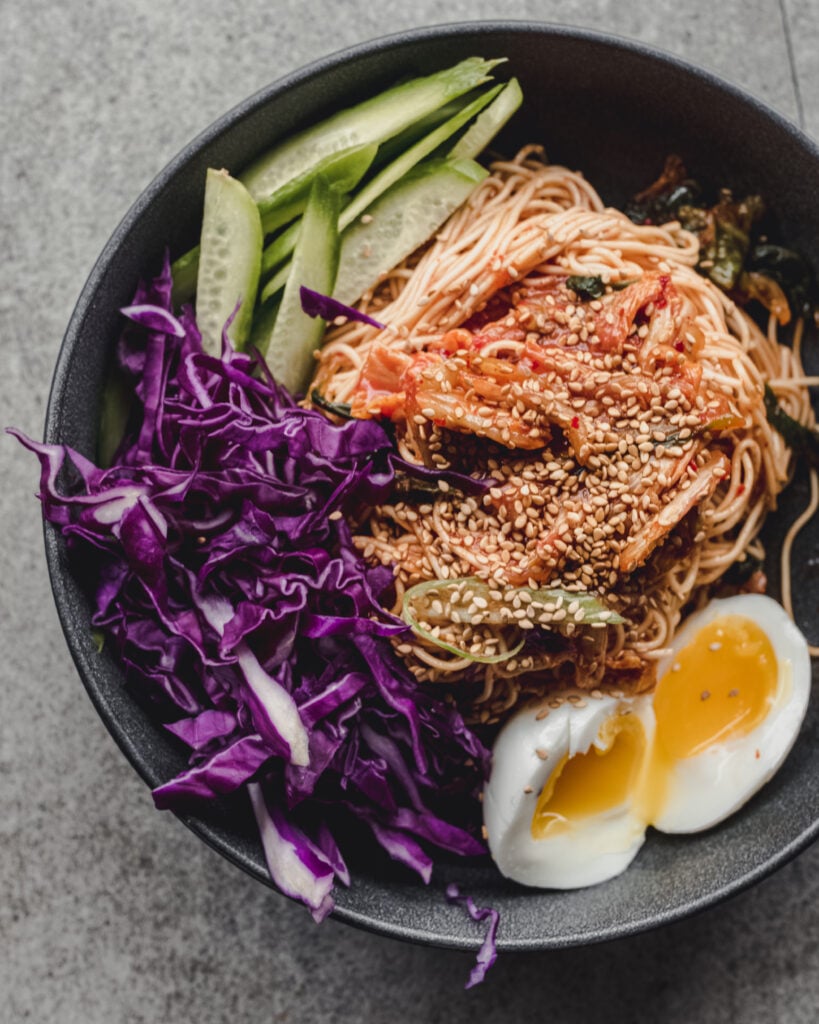
Ingredients:
- Somyeon (Somen). Thin wheat flour noodles that cook very quickly (3-5 minutes). In Korean, they are called Somyeon. In Japanese, they are called Somen. The thin, long strands twist together in a satisfying, delicious heap. Makguksu or Soba buckwheat noodles are also good substitutes. In a pinch, Angel hair pasta works.
- Sauce: Gochujang (Korean chili paste), Rice Vinegar (or regular white vinegar), Sugar, Soy Sauce, Sesame Oil, Garlic. All these pantry ingredients last a long time and make a perfectly balanced sauce that’s spicy, sweet, tangy, and fragrant.
- Kimchi + Kimchi Juice. Adds a spicy kick of flavor and acidity. Not the same without it!
- Veggies. To add freshness, crunch, and color. Julienned cucumber, carrot, or even Korean pear all make nice additions. As does finely shredded cabbage or chopped lettuce leaves such as Bibb or Butter Lettuce.
- Hard Boiled or Soft Boiled Egg. A classic addition to any Korean cold noodle dish! Adds protein and richness. I like soft-boiled eggs with runny yolks, but hard-boiled eggs are also very good.
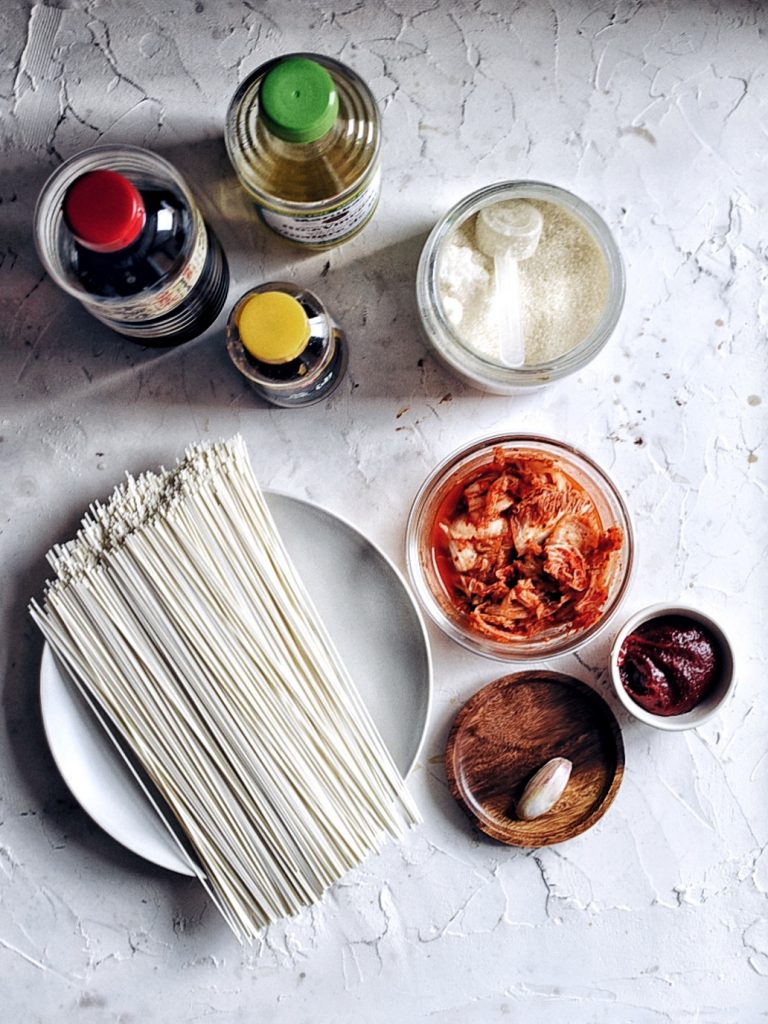
How to make Korean Spicy Cold Noodles:
- Cook noodles. In a medium saucepan, bring water to a boil. When the water is boiling, add the noodles and cook until al dente, about 3-5 minutes. Drain and rinse in cold water. Set aside.
- Make sauce. In a medium or large bowl, add the sauce ingredients. Use a whisk or spoon to mix until the sauce is smooth and well combined.
- Combine noodles and sauce. Add chilled drained noodles to the sauce. Using tongs, mix until the noodles are evenly coated in sauce.
- Add kimchi and kimchi juice. Add kimchi and a little kimchi juice to the noodles. Using tongs, mix well.
- Serve. Divide Bibim Guksu evenly between two bowls. Top with cucumber, red cabbage, and hard or soft-boiled egg. Garnish with sesame seeds. Serve with additional sesame oil on the side. Enjoy!
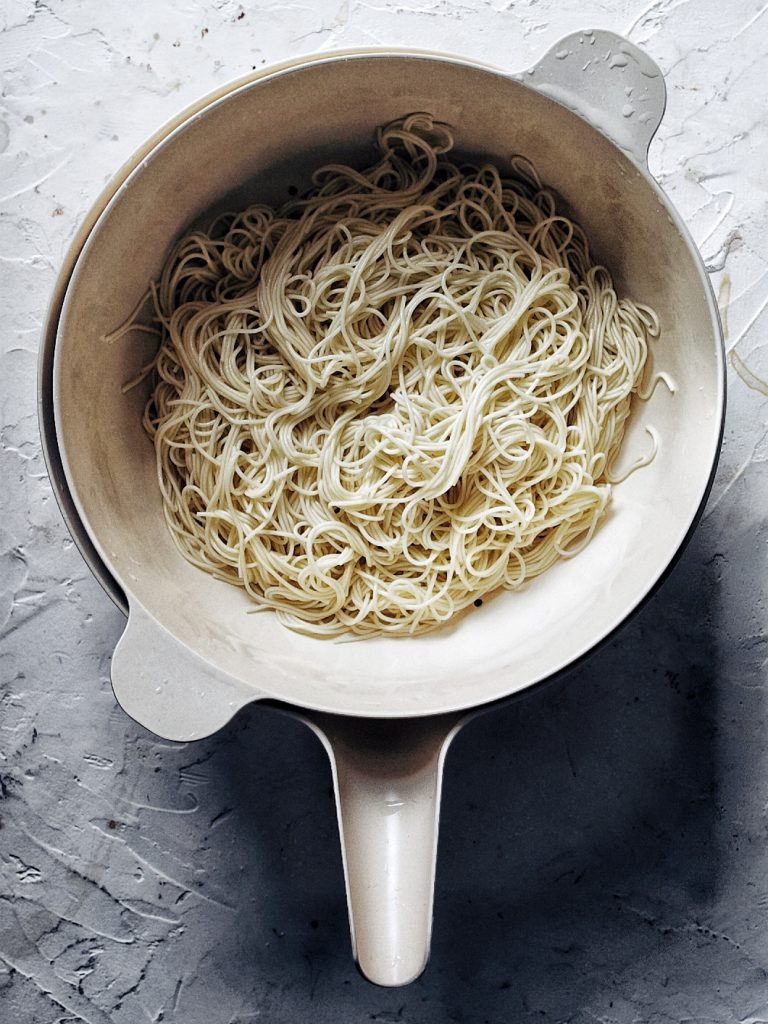
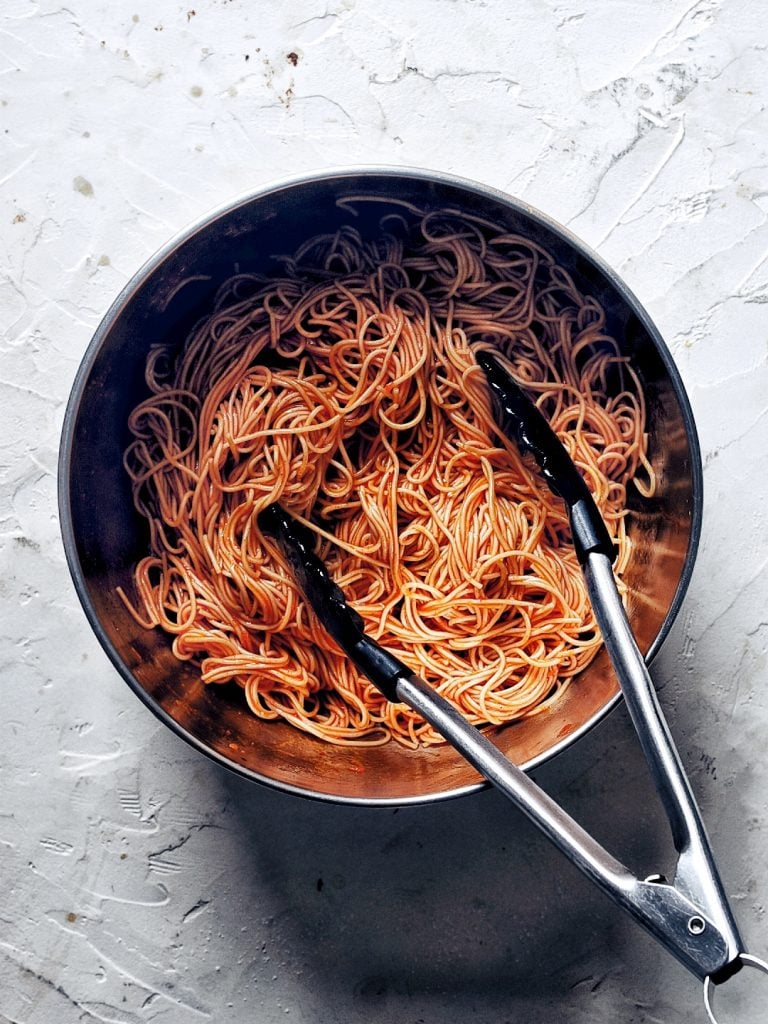


PRO Tips:
- Do not overcook the noodles. The texture of the Somyeon noodles is everything! They cook fast, in about 3-5 minutes, so don’t walk away. Instead, set a timer and set up the colander in advance.
- Rinse noodles with cold water. Stops the cooking process and ensures the noodles are perfectly chilled.
- Add more sesame oil. If the noodles are dry while mixing, add a drizzle of sesame oil. It will help the noodles to unstick.
- Taste and adjust seasoning. Since kimchi is a fermented food item and changes flavor as it ages, the final taste of the dish may need adjustment before serving. Before plating, I taste and adjust seasonings accordingly: if it’s too salty, add a pinch of sugar. If it’s bland, add a splash more kimchi juice.
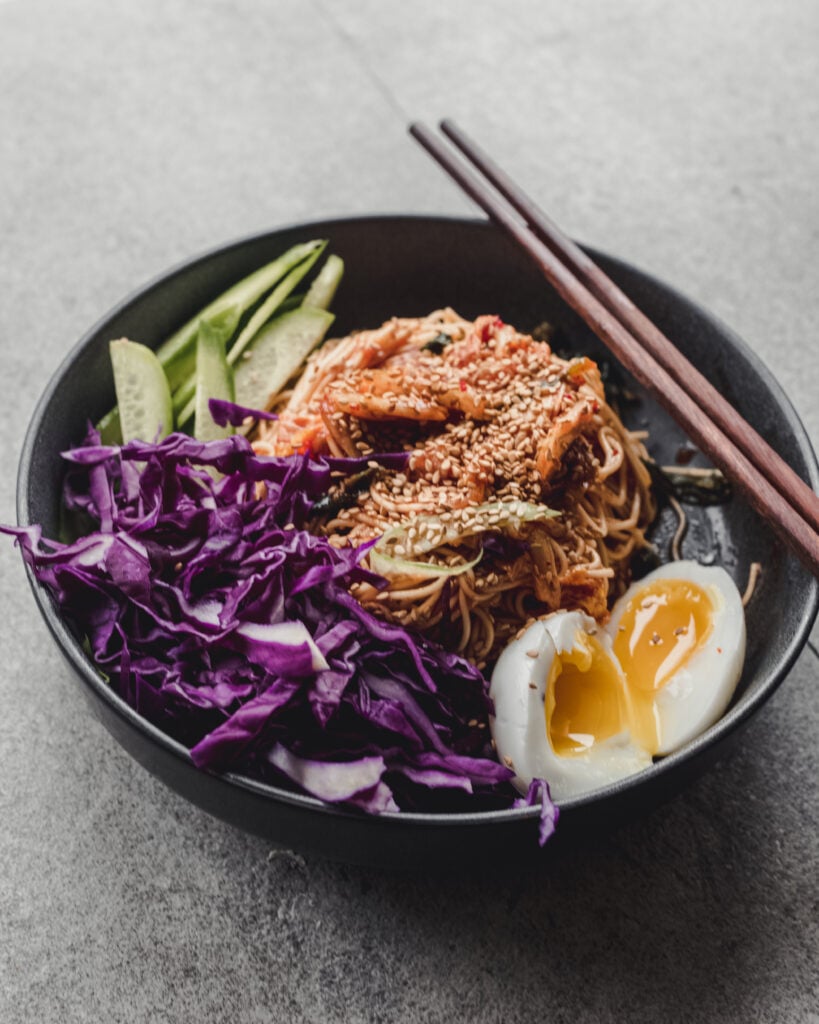
How to serve:
Korean Bibim Guksu can be enjoyed several ways:
- Main meal. Enjoy Bibim Guksu as a main meal. Lots of finely shredded veggies (in this case, cabbage and cucumber), alongside a soft-boiled egg make it complete.
- Side dish. Serve alongside your favorite KBBQ grilled meats. Some favorites include Samgyeopsal (Grilled Pork Belly, LA Galbi or BBQ Beef Short Ribs, Spicy Pork Belly Bulgogi, Osam Bulgogi (Squid and Pork Belly Bulgogi), or Beef Bulgogi. Cold Noodles and BBQ Meat is a classic Korean pairing.
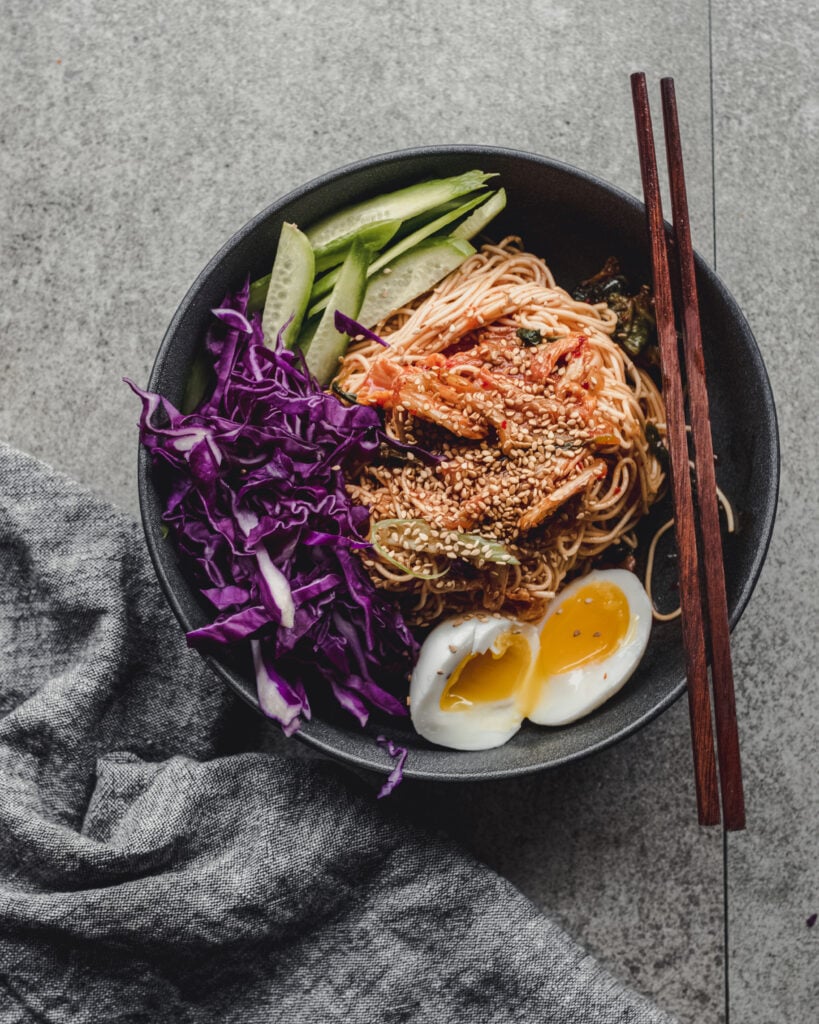
FAQ:
Korean Spicy Cold Noodles taste best when eaten immediately. That way, the noodles keep their twisty, soft texture. However, the sauce and toppings can be prepped ahead of time. They can keep 3-5 days in the fridge, tightly covered. Cook the noodles right before serving. When it’s time to eat, mix everything together and serve
Somyeon, also called Somen in Japanese, is the classic noodle used for Bibim Guksu. You can also use Makguksu, which is another Korean thin wheat noodles. And even Soba, also called Memil Guksu in Korean, which is buckwheat soba noodles. In a pinch, angel hair pasta can also be used.
The main difference is the type of noodle that’s used. Bibim Guksu refers to thin, wheat noodles like Somyeon/Somen. Bibim Naengmyeon refers to noodles made from buckwheat, arrowroot, and/or sweet potato starch. Long and dark, Naengmyeon noodles have more stretch and chew. The texture is not as soft but pleasantly chewy and slightly tough.
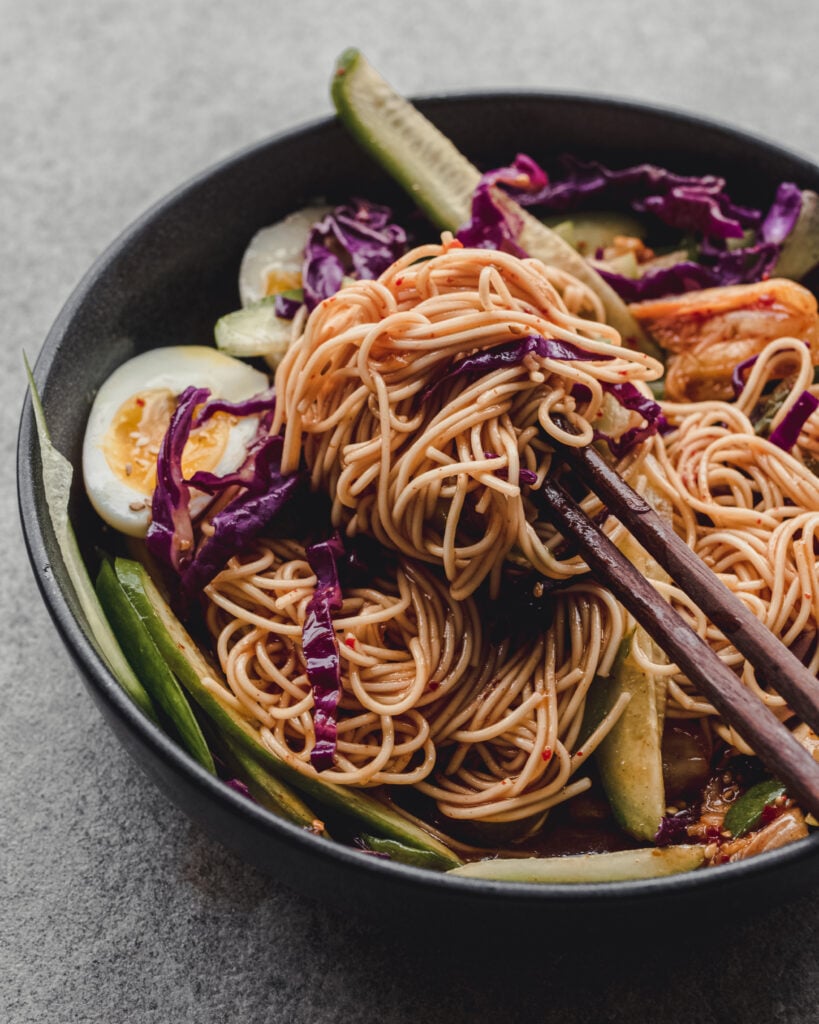
More noodle recipes:
- Buckwheat Soba Noodles with Perilla Oil
- Spicy Soba Noodle Salad
- Ramdon (Chapaguri) with Steak
- Dak Gomtang (Korean Chicken Noodle Soup)
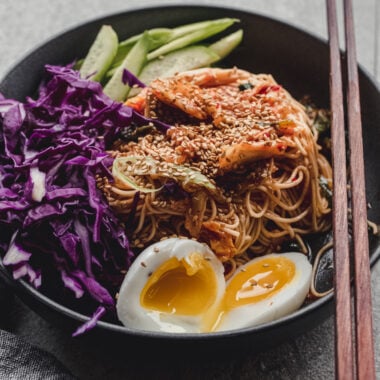
Korean Spicy Cold Noodles (Bibim Guksu)
Equipment
- Colander
- Medium cooking pot
- tongs
Ingredients
- 10 oz/ 285g Somyeon (Somen) *Korean or Japanese thin wheat noodles
Sauce
- 2 Tbsp Gochujang *Korean chili paste
- 2 Tbsp rice vinegar *white vinegar or apple vinegar also works
- 2 Tbsp sesame oil *plus more for drizzling
- 2 Tbsp sugar
- 1 Tbsp soy sauce
- 2 cloves garlic *minced
- 1/2 cup kimchi + kimchi juice
Additional Toppings: (optional)
- 1/2 cup julienned cucumber, divided
- 1/2 cup shredded red cabbage, divided
- 2 soft or hard-boiled egg, halved (1 for each serving)
- sesame seeds
Instructions
- Cook noodles. Bring a large pot of water to boil. When the water comes to a boil, add Somyeon noodles. Cook according to manufacturer's instructions. (The noodles should be soft but not overcooked, about 3-4 minutes.) Drain and rinse with cold water until noodles are cold to the touch.
- Make sauce. While the cooled noodles continue to drain, make the sauce. In a large bowl, add sauce ingredients. Mix with a spoon until well combined and no clumps remain. Set aside. (The sauce can be made ahead of time and stored in the fridge, tightly covered, for up to 3-5 days beforehand.)
- Mix noodles and sauce. Add drained noodles to the sauce and mix well.
- Season with kimchi and kimchi juice. Add kimchi and juice and mix well. Drizzle with additional sesame oil if the noodles look dry.
- Serve and enjoy! Evenly divide between two bowls. Scrape all the remaining sauce + kimchi onto the noodles. Top with cucumber, red cabbage, egg, and sprinkle of sesame seeds. Serve immediately, with more sesame oil for drizzling if needed.
Video
Notes
- Be careful not to overcook. The texture of the Somyeon noodles is everything!
- Rinse noodles with cold water. Stops the cooking process and ensures the noodles are perfectly chilled. This is a cold noodle dish, after all!
- Add more sesame oil. If the noodles are dry while mixing, add a drizzle or more of sesame oil. It will help the noodles to unstick.
- Taste and adjust seasoning. Since kimchi is a fermented food item and changes flavor as it ages, the final taste of the dish may need adjustment before serving. Before plating, I taste and adjust seasonings accordingly: if it’s too salty, add a pinch of sugar. If it’s bland, add a splash more kimchi juice.




nice information and good article thank you for you recipee
Pingback: Ina Cheat Day: The Subversive Table – Store Bought Is Fine
What brand of soy sauce did you use?
I use Yamasa. It’s a Japanese brand. Don’t use the low sodium kind!